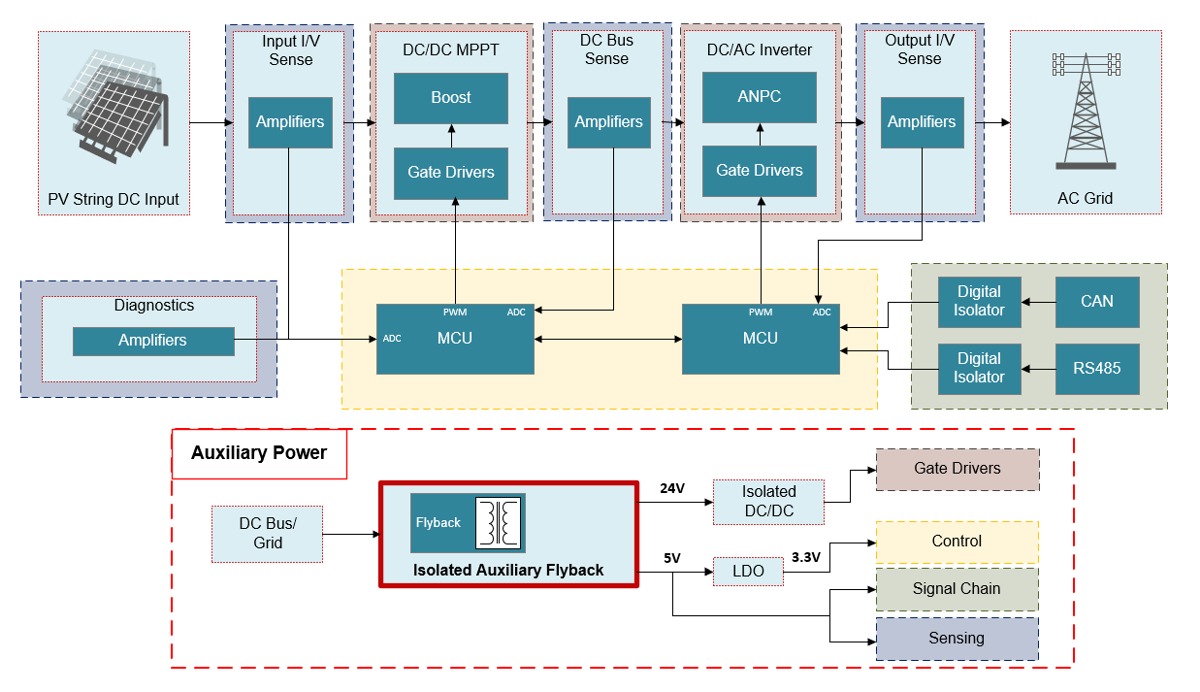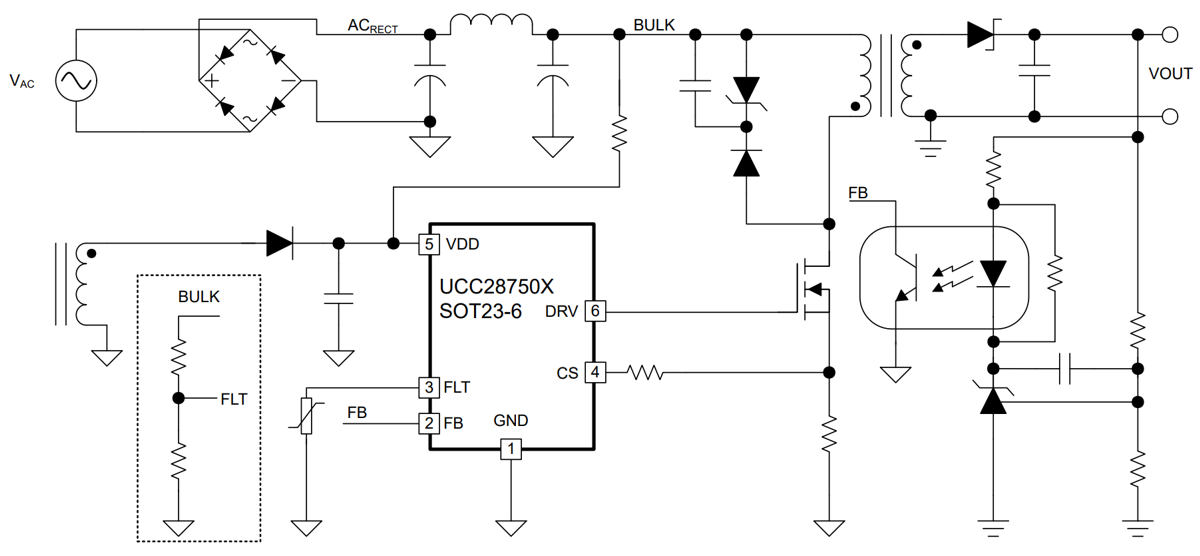SSZTD17 January 2024 UCC28750
The landscape of power conversion is ever-changing. Higher voltages, reliability and efficiency are of the utmost importance, and as such, these trends impose increasingly stringent conditions to fixtures such as the auxiliary power supply, often in the form of a flyback that converts voltage from a DC bus or the AC grid into internal DC power rails.
In this article, the basic functionality of an industrial application is broken down, the importance of the auxiliary power supply to this functionality, and how the new UCC28750 flyback controller from Texas Instruments can help you to design an effective industrial auxiliary power supply.
Auxiliary flyback supplies in industrial applications
A solar string inverter converts the DC voltage generated from photovoltaic panels to AC grid power. To accomplish this, inverter systems use multiple power-conversion stages, the first of which is the DC/DC stage, which generates a stable DC bus voltage from the photovoltaic string DC input. An inverter stage then converts this DC bus voltage into an AC voltage for feeding into the grid. Figure 1 showcases a simplified solar string inverter diagram.
 Figure 1 Simplified solar string
inverter diagram with the auxiliary power-supply architecture
Figure 1 Simplified solar string
inverter diagram with the auxiliary power-supply architectureIn order for this conversion to take place, power stages use a number of devices broken down into a few critical areas. Both the DC/DC and DC/AC power stages use gate drivers to drive the field-effect transistors (FETs) for efficient operation. Sensing devices – typically in the form of amplifiers – gather sensory data for proper control and safety. Signal-chain integrated circuits communicate with external interfaces. The control domain, consisting of microcontrollers, gathers information from all of the above to enable efficient and reliable power conversion.
With such dependency on so many different devices, it only makes sense that the auxiliary power supply is just as important to proper solar inverter operation. Designed to provide power to the control, signal-chain, sensing and gate-driver devices, the auxiliary power supply typically comes in the form of an isolated flyback controller that converts voltage from the DC bus or AC grid (or both) into a form suitable to ensure internal device operation. Without this fixture, the system electronics would have no supply to keep them operational, jeopardizing the entire system.
As such, the flyback controller has a few key requirements. It should have high lifetime reliability and be able to operate under severe conditions (such as in the case of a solar inverter, which is often exposed to high ambient temperatures across varying degrees of altitude for many years). Accordingly, the flyback controller should have an extended operating temperature range and be able to shut down operation should the controller or external circuitry exceed safe operating temperatures. This is, of course, in addition to fault protections such as short-circuit detection.
Another consideration is the flyback controller’s ability to enable efficient full and light-load operation per the design requirements. When the solar panels are exposed to sunlight and power conversion is at its peak, the auxiliary power supply should be able to efficiently supply higher output power to the internal electronic subsystems. Conversely, at light-load conditions when there is no sunlight, the auxiliary power supply should be able to minimize standby power so as to not consume excess power in an idle state.
Finally, the auxiliary supply should be able to ensure the continuous application of the proper bias conditions to the internal subsystems throughout various operating conditions. For example, devices such as gate drivers depend on the correct bias voltage in order to properly drive the FETs and reduce conduction losses. Simultaneously, the auxiliary power supply should be capable of delivering stable low-voltage rails for the control and sensing devices. The auxiliary power supply can be directly responsible for maintaining these voltages throughout system operation.
Enabling an effective auxiliary power-supply design
TI’s UCC28750 flyback controller, as seen in Figure 2, comes in a six-pin package that features secondary-side regulation through optocoupler feedback, which enables fast transient response and accurate output regulation for applications that require low voltage ripple. For solar inverters, which depend on the auxiliary power supply for powering many electronic subsystems, secondary-side regulation can help ensure the proper bias power throughout variable operating conditions.
 Figure 2 The UCC28750 in a flyback
design
Figure 2 The UCC28750 in a flyback
designA notable inclusion with the UCC28750 is a programmable FLT pin. Depending on the device variant, this pin enables the implementation of brownout detection or simultaneous output over-voltage and external over-temperature protection (OTP) with few external components.
Brownout detection allows the device to sense the line voltage, and stop switching operation when the voltage drops below a custom threshold for a set amount of time. Meanwhile, a feature such as external OTP allows the device, with a negative temperature coefficient resistor, to detect when an area or component on the board exceeds a certain temperature. Features like these – in combination with over-power, short-circuit and internal thermal shutdown protections – can enable a reliable auxiliary power-supply design that can endure the severe operating conditions of solar inverters.
The UCC28750 also has an optimized control law for variable load conditions. In order to improve efficiency and standby power during light-load conditions, the controller reduces the switching frequency and enters burst mode, where the switching operation cycles on and off. Conversely, at higher-load conditions, the controller raises the primary-side current limit and switching frequency. Internal programmable slope compensation enables continuous conduction mode operation (in addition to discontinuous conduction mode), which can help reduce conduction losses for improved efficiency at higher output power, such as when the solar panels are fully exposed to sunlight. Such a control law can enable a solar inverter auxiliary power supply that maintains efficient operation regardless of environmental conditions.
Conclusion
It is possible to mitigate the challenges of designing an effective auxiliary power supply with the proper flyback controller. TI’s flyback controller portfolio can help you achieve high performance and reliability while maintaining design simplicity and cost optimization for industrial applications such as solar inverters.
Additional resources
- Download the UCC28750 data sheet
- Check out TI’s flyback controllers portfolio page
- See the 350-V to 1500-V Input, 150-W Isolated Auxiliary Power Reference Design